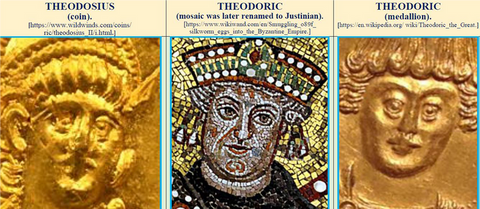Gunnar Heinsohn: Ravenna and Chronology

Gunnar Heinsohn’s RAVENNA AND CHRONOLOGY is a 100 page, abridged English version of his 550-page German manuscript WIE LANGE WÄHRTE DAS ERSTE JAHRTAUSEND? (How long did the First Millennium last?) The project was begun in February 2011. Q-MAG.org published then its first overview under the title THE CREATION OF THE FIRST MILLENNIUM in November 2013.
Q-MAG.org will present RAVENNA AND CHRONOLOGY in three parts, richly illustrated. The summary at the end is wrapped up in a concise table which we are showing here up-front, for it conveys some of the most important results that Heinsohn's text is striving to establish.

I asked Gunnar Heinsohn if we may end up having to go back behind Michael Psellos (ca. 1018-1078 AD) and start A.D. history all over again? His answer was YES. "It may seem frightening, he added, to have to abandon nearly 1,000 years of historiography dealing with the first millennium AD. In reality we have it much easier than Psellos did. Believing in the Revelation of John, he could not help but identify the extinction of Roman civilization, less than a century before his time, as the Second Coming of Christ:
“The Angel chained Satan for 1,000 years. He could not fool the nations anymore until the 1,000 years were completed” (Revelation 20, 1-3).
Psellos and his followers saw themselves more than a millennium after Christ and had to fill all that time with narratives. We, on the other hand, have the archaeological evidence of the past 200 years. With its guidance, we can separate the authentic from the merely narrated..."
Anne-Marie de Grazia (May 2020).
Ravenna and Chronology: 1st Installment
- Can Ravenna, ‘Capital of Late Antiquity’, make up for Rome's missing archaeology between the 230s and 930s AD?
- Ravenna’s assumed first collapse in the 3rd century, later followed by the collapses of the 6th and 10th century
- Artificial extensions of Late Antiquity’s chronology through the multiple use of identical historical sequences
Ravenna and Chronology: 2nd Installment
- Why do 5th/6th c. Ostrogothic elites continue to live in Roman-style elite houses of the 2nd/3rd c. Severan period?
- Why are Ravenna's monuments of the 5th/6th century constructed like a palimpsest with bricks of the 2nd/3rd century?
- Why is Justinian (520s-560s AD), who cooperated with Severan emperors (190s-230s AD), dated more than 300 years later?
- Can Germany and Aachen, ‘Capital of the Early Middle Ages’, provide the settlement layers missing in Ravenna?
New: Ravenne and Chronology: 3rd Installment
- AACHEN segment of “Can Germany and Aachen, ‘Capital of the Early Middle Ages’, provide the settlement layers missing in Ravenna?”
- The Fall of Roman Civilization and the Destruction of Ravenna
- Summary
- Bibliography
- Acknowledgements

